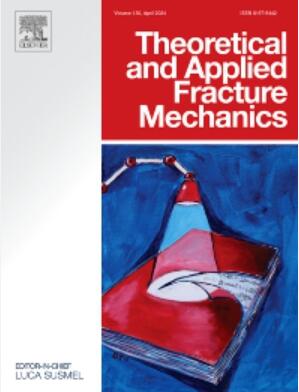Numerical and photoelastic investigation of the effect of material cracks on interfacial cracks
IF 5.6
2区 工程技术
Q1 ENGINEERING, MECHANICAL
引用次数: 0
Abstract
This study presents the numerical analysis of the interaction of a material crack with an interfacial crack in a bimaterial system focussing on a rock-concrete bimaterial. The numerical model is validated using photoelasticity by comparing the numerically plotted isochromatic fringes with the experimental ones. Epoxy-polycarbonate bimaterial pair with an interfacial crack subjected to compression is used for the experiments and numerical analysis. This material pair is chosen as it has the similar bimaterial ratio as that of a rock-concrete bimaterial pair. The validated numerical model is then used in conjunction with a recently developed approach for fracture parameter evaluation using isochromatics plots to study the Stress Intensity Factor (SIF) variations with respect to different inclination angles and to study the interaction of interfacial crack with another material crack present in one of the materials. The results indicate that the inclination of the interface has an effect on the mode of failure. It is found that the interaction of the material crack increases the SIFs for the interface crack for all the different configurations of the material crack. The variation of SIFs with respect to the orientation of the material crack and the distance between the interface and the material crack are also studied.

材料裂纹对界面裂纹影响的数值和光弹性研究
本文以岩石-混凝土双材料为研究对象,对双材料系统中材料裂缝与界面裂缝的相互作用进行了数值分析。用光弹性法将数值绘制的等色条纹与实验结果进行了比较,验证了数值模型的正确性。采用具有压缩界面裂纹的环氧树脂-聚碳酸酯双材料对进行了实验和数值分析。选择这种材料对是因为它具有与岩石-混凝土双材料对相似的双材料比。然后,将验证的数值模型与最近开发的断裂参数评估方法相结合,使用等色图来研究应力强度因子(SIF)随不同倾角的变化,并研究其中一种材料中存在的界面裂纹与另一种材料裂纹的相互作用。结果表明,界面倾角对破坏模式有影响。研究发现,对于所有不同形态的材料裂纹,材料裂纹的相互作用都增加了界面裂纹的SIFs。研究了SIFs随材料裂纹方向和界面与材料裂纹距离的变化规律。
本文章由计算机程序翻译,如有差异,请以英文原文为准。
求助全文
约1分钟内获得全文
求助全文
来源期刊

Theoretical and Applied Fracture Mechanics
工程技术-工程:机械
CiteScore
8.40
自引率
18.90%
发文量
435
审稿时长
37 days
期刊介绍:
Theoretical and Applied Fracture Mechanics'' aims & scopes have been re-designed to cover both the theoretical, applied, and numerical aspects associated with those cracking related phenomena taking place, at a micro-, meso-, and macroscopic level, in materials/components/structures of any kind.
The journal aims to cover the cracking/mechanical behaviour of materials/components/structures in those situations involving both time-independent and time-dependent system of external forces/moments (such as, for instance, quasi-static, impulsive, impact, blasting, creep, contact, and fatigue loading). Since, under the above circumstances, the mechanical behaviour of cracked materials/components/structures is also affected by the environmental conditions, the journal would consider also those theoretical/experimental research works investigating the effect of external variables such as, for instance, the effect of corrosive environments as well as of high/low-temperature.
 求助内容:
求助内容: 应助结果提醒方式:
应助结果提醒方式:


